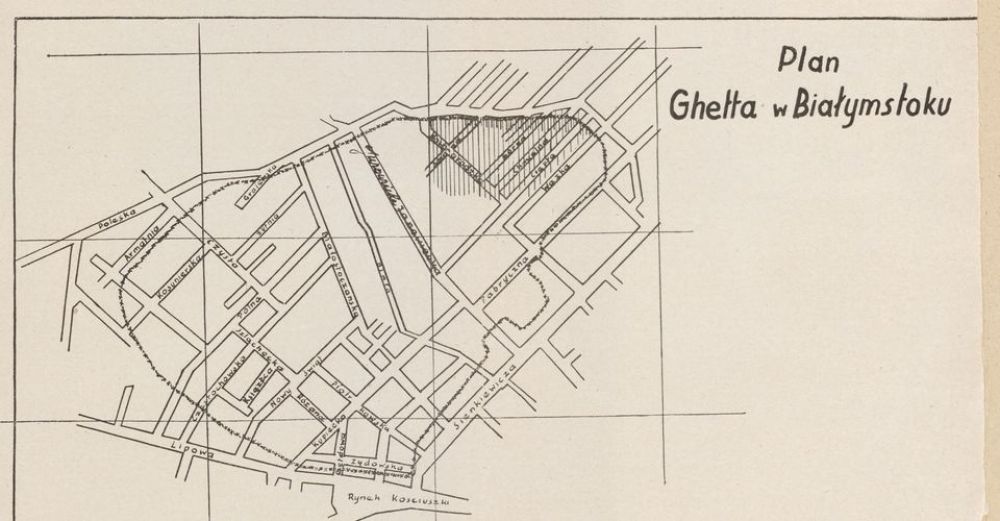- News
- Events
- Oneg Shabbat
- Collections
- Research
- Exhibitions
- Education
- Publishing Department
- Genealogy
- About the Institute
- Bookstore


Bialystok district was incorporated into the Third Reich in July 1941. At that time, also the Bialystok Ghetto was created, where 45,000 Jews were locked. This situation lasted until February 1943, when the Germans began the deportation action from the ghetto. “On the streets froze life, laughter and noise was gone”, wrote Szymon Datner after the war, a historian, but also a witness to these events. “Excruciating was the sight of young children, apathetic and subdued, aware of what was awaiting them. Who will describe the anguish of the parents who were aware of the fate, utter helplessness in the face of the inevitable extermination. Within a few cold days, from the Bialystok Ghetto one-third of its inhabitants was deported”.
Although at the time of the displacements in February, the armed underground was already operating in the ghetto, its members failed to carry out an organized resistance action. The commanders lacked experience and a clear plan of action. Their effectiveness was also weakened by the continuing division of the underground’s structures, consisting mainly of communists, Block A and Block B, formed by Zionist youth organizations, and the Bund.
It was not till July that the unity of the Jewish conspiracy was possible. The head of the new organization was Mordechai Tenenbaum from Zionist Dror, which earlier had taken part in the creation of the Jewish Fighting Organization in Warsaw. Communist Daniel Moszkowicz was appointed his deputy. Now, the organization had about 200 people, a hundred guns, about a dozen rifles, and grenades produced in the workshops hidden in the ghetto area. In addition, about 150 Bialystok Jews fought in partisan units operating in, surrounding the city, Knyszyńska Forest.
Six months after the first action, the Germans began the second and final action of the liquidation of the ghetto in Białystok. During the night of August 15, German troops surrounded the ghetto with a triple cordon. The surprise of its civilian inhabitants was complete. Datner reported, “It has never been so cheerfully in the ghetto as during the last days preceding its destruction. It was during the period after Stalingrad, the El Alamain, after the victorious [for the Allies] end of the North African campaign and landing in Sicily. [...] Help was coming. The Germans continued to be committed to winning the war — with the Jews”.
During the night, the fighters handed out weapons stored in storehouses and agreed on the plan of action. Their main goal was to make a hole in the wall of the ghetto and struggle out of it to the forest with as many residents of the ghetto as possible. Unfortunately, the plan did not succeed. The Germans, having the experience gained in the Warsaw Ghetto uprising, were well prepared for the elimination of the Białystok Jewish communities. “The fight is uneven. About 300 poorly armed Jews fighting against the SS troops consisting of over three thousand soldiers armed only with machine guns,” wrote Datner. “To the fight against the Jewish fighters they added also armored cars, light tanks and... aircrafts”.
Minor clashes occurred in various parts of the ghetto during a few following days. A big blow to the Jewish fighters was the detection by the Germans of the bunker at 7 Chmielna Street, where more than 70 members of the underground were hiding. On 20th August commanders: Tenenbaum and Moszkowicz, having realized that the fight was coming to an end, committed suicide. Very few fighters managed to run away into the forest. Most of them perished in the uprising. The other residents of the Bialystok ghetto were deported to Treblinka and labor camps in the Lublin region, where after a short time they were killed.
The quotes used in the text come from a publication by Szymon Datner “Walka i zagłada białostockiego getta” (The fight and the destruction of the Bialystok Ghetto) published in 1946 in Lodz. Thanks to the efforts of the JHI, a critical re-edition of this book will be rereleased this year.
***
Szymon Datner (1902–1989) was a historian and social activist. Just before the outbreak of the war, he accepted the post of a teacher in a Hebrew gymnasium in Białystok. He participated actively in the underground. In June 1943, he managed to get out of the ghetto and joined partisan units fighting in nearby forests. After the war he went to Palestine for a short time. After his return, he worked at the Jewish Historical Institute and the Central Commission for the Investigation of Nazi Crimes. He wrote, among others, cited in the above text, publication “Walka i zagłada białostockiego getta” (The Fight and the Destruction of the Bialystok Ghetto) and „Las sprawiedliwych”(The Forest of Righteous): the first book in Poland on the rescue of the Jews by the Polish.